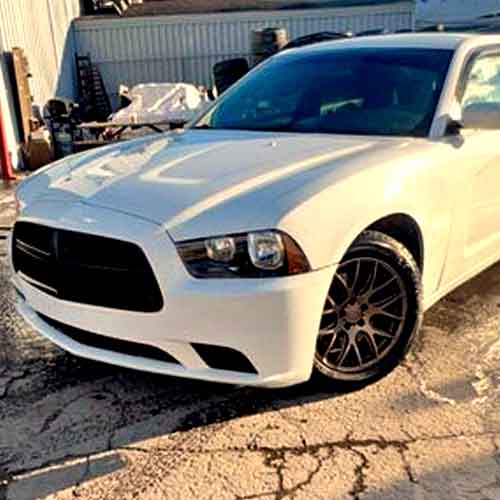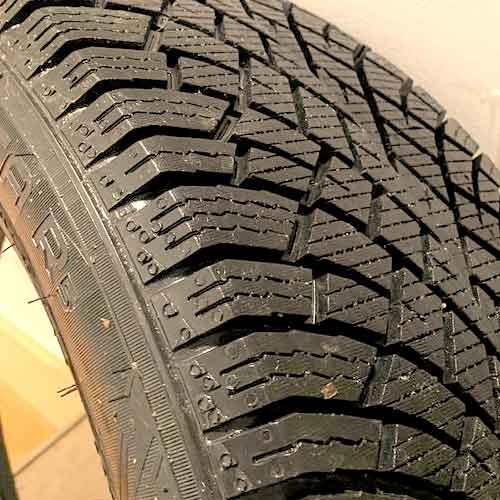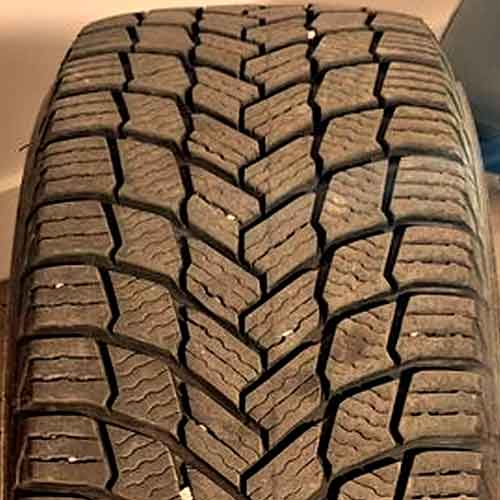Both the Michelin X Ice Snow and Nokian Hakkapeliitta R5 are distinguished performers in winter tire technology, each specializing in different aspects of grip, tire longevity, and ride comfort, providing a variety of choices for a range of driver expectations and driving environments.

Table of Contents
Available Sizes Info
The Michelin X-Ice Snow (review) comes in 125 total sizes in 15 to 22 inches. They have following specs.
- Speed ratings: T and H.
- Load ratings: SL and XL.
- Tread depth: 10.5/32″ on all.
- Weight: 16 to 40 lbs.
- Tread warranty: 40k miles.
On the other side, the Nokian Hakkapeliitta R5 comes in 14 to 20 inches with following.
- Speed ratings: R and T.
- Load ratings: SL and XL.
- Tread depth: 11.5/32″
- Weight: 15 to 35 lbs.
- Tread warranty: None.
Tread Design
Starting with the Nokian Hakkapeliitta R5, the tire while also boasting a directional tread pattern, presents a distinctly different design.

In the central area, there is a continuous rib, much like what you would find in its competition. This rib is intricately structured with numerous in-groove notches and particularly aggressive wave-like sipes.
The lugs that surround this rib have a blocky, squared-off design, though they mimic the central siping pattern. As you move further outward, you’ll notice the lugs becoming increasingly elongated, resulting in the shoulder blocks being the most elongated.
These shoulder lugs display saw-toothed edges on both lateral sides, and their siping pattern is slightly thicker.
It’s important to note that all the lugs, including the central ones, are seated on a secondary rubber layer beneath, serving as reinforced foundations.
The Michelin X-Ice Snow, on the other side, also proudly presents a distinctive, directional tread design.

This tread design features four circumferential channels centrally located, exclusive of the shoulder ribs.
At the core of the tread lies a challenging interlocking, zigzag groove, contributing to its tough nature.
This central channel is shaped by lugs on each side, endowed with a combination of straight and wave-like siping, offset edges, and snow vices. These snow vices refer to the stepped edges located on the corners of the lugs.
Moving outward from the center, the tread transitions to more squared-off blocks, each bearing only wave-like sipes.
The shoulder areas of the tread are characterized by robust, thick siping slits, complemented by the serrated edges visible on the lateral sides.
Comfort Levels
Ride comfort can be distilled down to noise dampening and shock absorption capacity of the tire.
Let’s start with noise, which is primarily generated when air particles collide with the tread walls. So, wider tread gaps result in a louder tire.
That’s why here the Nokian Hakkapeliitta R5 is taking the lead with it’s compacted up tread pattern.
Moreover, the tire also offers superior pitch sequencing technology. This approach utilizes variations in tread block geometry to generate different tones which cancel each other out, reducing noise.
Meanwhile, the Michelin X-Ice Snow excels in vibration dampening, courtesy of its softer overall tread compound. The softer tread construction improves shock absorption, leading to a smoother ride.
Winner: Both!
Tread Mileage
Tread longevity hinges on a mix of factors like the tire’s weight, tread depth, design, and material composition. In light of these factors, the Michelin X-Ice Snow shines.
This tire is lighter, so there is less weight stress on each lug, which reduces friction against the road surface.
Additionally, the tire’s relatively stiffer rubber prolongs the tire’s life, as it takes longer to wear down to replacement levels.
In comparison, although the Nokian tire also offers a decent tread life, thanks to its larger tread depth, it still falls short compared to its counterpart.
That’s why it makes sense why Michelin offers 40k miles warranty here, whereas Nokian doesn’t come with any.
Winner: Michelin.
Fuel Usage
Fuel efficiency in tires is closely tied to tread design and weight, as these factors tell you about the overall rolling resistance, (which directly impacts fuel usage).
Having said that, both tires here, offer comparable rolling resistance levels, meaning, you can’t put one tire over the other here.
Although the Michelin X-Ice Snow is lighter and has wider tread voids which would create additional lug movement during maneuvers, leading to increased fuel usage, its only equal to that seen on its counterpart, which is heavier (pushing its lugs against the road with greater force).
Winner: Both!
Fluffy Snow Traction
In softer snowy conditions, the Nokian Hakkapeliitta R5 takes a slight lead, and this is attributed to its comprehensive array of biters that act as snow traps.
These snow traps foster robust snow-to-snow interaction, forming the tire’s contact patch with the ground and boosting traction. The reason being that snow bonds better to itself than to rubber.
Moreover, the tire’s streamlined and curvilinear tread pattern enhances performance by creating a paddling effect that scoops and ejects snow, driving the vehicle forward.
In comparison, the Michelin X-Ice Snow lacks these specific traits.
While its tread pattern is also directional, it lacks the streamlined pattern, as seen on its competitor, thus decreasing its ability to move snow backwards to generate forward momentum.
And yes, this combined with the fact that this tire has fewer interconnected tread voids than its competitor, it makes sense why Nokian is taking the lead here.
Winner: Nokian.
Wet Grip
In terms of wet grip, both tires benefit from abundant siping and flexible tread rubber, offering excellent directional grip.
And here, our testing reveals similar braking distances for both tires, demonstrating comparable wet grip.
However, the Michelin X-Ice Snow outperforms slightly in terms of handling, owing to its superior water clearance capabilities. This advantage is a result of multi-angled sipes and notches oriented both laterally and longitudinally on its shoulders.
This design fosters all-directional grip during cornering, mitigating slippage risk.
Conversely, the Hakkapeliitta R5, featuring only laterally oriented sipes on its shoulders, exhibits minor deficits in overall handling times during testing.
Winner: Michelin.
Directional Grip
Directional grip effectiveness primarily relies on the tread’s central zone, as it shoulders most of the tire load, particularly during straight-line driving on highways.
And given this parameter, it’s clear why the Nokian Hakkapeliitta R5 gets to have the upper hand.
While both tires feature continuous central ribs for persistent road contact, the Hakkapeliitta R5 features a more enclosed pattern, extending even to the peripheral lugs.
This attribute contributes to an average braking distance reduction of 4 feet in tests, outperforming the Michelin X-Ice Snow.
Winner: Nokian.
Lateral Traction
Handling quality largely depends on the tire’s shoulders and overall weight.
During cornering, inertia shifts the weight to the tread’s periphery.
Despite the Nokian Hakkapeliitta R5’s closely packed shoulder voids, its heavier weight proves a setback.
The increased weight results in elevated lug movement when cornering, thereby diminishing steering feedback.
In contrast, the lighter Michelin X-Ice Snow maintains a better balance between understeering and oversteering, enhancing overall steering responsiveness.
Winner: Michelin.
Ice Traction
Regarding performance on icy surfaces, the Michelin X-Ice Snow indisputably leads the pack.
This tire features innovative design components, including dedicated biters scattered across the tread equipped with snow vices.
Coupled with a diverse range of siping angles, the Michelin X-Ice Snow provides impressive braking and acceleration capabilities on icy surfaces.
On the other hand, despite featuring numerous in-groove notches, the Nokian Hakkapeliitta R5 lacks an assertive siping pattern.
Although its sipes interlock, they accommodate fewer biters and lack the diversity of angles present in the Michelin X-Ice Snow, resulting in a compromised grip on ice.
Winner: Michelin.
Summing Up
So lets see what it all comes down to.
The Nokian Hakkapeliitta R5 demonstrates prowess on snowy terrains with its comprehensive snow traps and streamlined tread design, offering superior snow traction. It also provides better directional traction on both wet and dry roads.
On the other hand, the Michelin X-Ice Snow excels on icy terrains, courtesy of its specialized biters and all-directional grip.
Moreover, this tire also delivers superior handling performance in both wet and dry conditions.